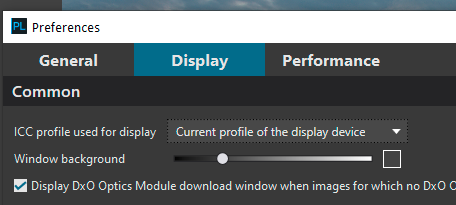When I switch from edit mode to fullscreen (F11), saturation and contrast changes massively after the image is loaded. Is there a way to adjust this?
Screenshot in edit mode:
Screenshot in fullscreen / preview mode:
When I switch from edit mode to fullscreen (F11), saturation and contrast changes massively after the image is loaded. Is there a way to adjust this?
Screenshot in edit mode:
Screenshot in fullscreen / preview mode:
What is the zoom level you are looking at in Edit?
Mar
Zoom level is relevant for denoising and lens correction, not for colour reproduction - otherwise you wouldn’t be able to to adjust saturation / vibrancy.
100% zoom edit window:
100% full screen window:
I have never noticed this in over 4 years of using PhotoLab on thousands of images. I assume the two images you posted are of the same unprocessed raw file.
Does this happen with all your raw files or only certain ones? What version of PhotoLab are you using? If you have used different versions of PhotoLab, is this issue specific to one version or to all of them? What camera was used to capture these images? Does it occur on images taken with other cameras? I’m thinking this issue may be camera specific. Is there a difference when viewing the image in the edit screen versus full screen mode even if there are no corrections applied? Sorry for all the questions, but I think it’s necessary to drill down to what may be the issue here.
Mark
Thanks Mark,
Happens to all files, regardless if it is raw or jpg.
5.1.2 Elite, build 4700
Right now I only have 5 installed. With PL3 I don’t think I’ve had this issue.
Nikon D7500, nothing really exotic I guess… It is my only camera.
Correct, even unprocessed, unedited photos without any corrections look overly saturated in the full screen mode.
Example:
Edit window:
Full screen:
This is the same picture in compare mode (full screen). If there would have been any corrections applied, there should be a difference between left / right.
I’m not home right now. However I will be home shortly and I will do some tests on my own to see if I can recreate the problem. I was primarily a Canon shooter for many years, but recently also required a Nikon Z fc. I will also download some raw files taken with a D7500. I’ll get back to you later today.
Mark
Had a look with DPL5 on macOS. There is no difference in displaying in edit vs. full screen modes.
FWIW: I tested this observation with an image with vibrant colours;
… but I can see no difference to colours/saturation between Fit to Screen and Full Screen modes.
In your case, it suggests rendition colour spaces may be different - but I can’t see how that’s possible (?)
John M
I think this is on Windows (because the full screen key is said to be F11), and I’m wondering if there is something happening that changes the screen calibration on going into full-screen mode there which would explain why Mac users don’t see this. Maybe there is a driver problem complicating things.
Also, are there any automatic HDR settings on the monitor?
I was delayed testing this on my Windows 10 machine until just now. I could not recreate this issue. I even downloaded a couple of D7500 raw files to test it and still don’t see the oversaturation issue you documented. Obviously something is causing it, I am just not sure what that might be.
Mark
Also no problem here – tried this already but was waiting for your comment. 
Don’t understand, why his happens in the very same program.
@geno, maybe you try to re-install (repair) PL.
Ok, so it obviously is an individual effect on my machine.
I run PL on a Lenovo P52 (Nvidia P2000 graphics) and an EIZO CS2420. Both screens were calibrated using Displaycal and X-Rite Colomunki.
When I switch to fullscreen, the image is displayed “correctly” (well…) for half a second and then the effect kicks in. Really weird.
I will install PL3 for comparison.
@geno, I didn’t ask – that happened on PL5 or 4?
What happens, when you unplug your external screen? Does the Lenovo’s screen show the same thing
– I guess that it will not …
OR do you use both screens (extended …). Then maybe the GPU reacts different (pure speculation).
BTW, I have on old Lenovo W520, but don’t use it with external monitor.
This sounds like it could be a color management problem. Are you using Windows 11? (There are known color management issues with Win11, especially if you are using two displays.)
Thanks, I am using Windows 10. The color management problem would live inside PL, because the OS has one profile for the external, and one for the internal screen.
I make use of both screens, having all the palettes on the Laptop screen and the EIZO for displaying the image.
Hopefully tonight I will have time to find out more.
Now two screenshots using only the laptop screen.
Edit window:
Fullscreen:
Looks identical for me. So PL seems to switch the colour profile in fullscreen mode. Interesting.
I have selected to use the profile of the currrent monitor. Maybe PL switches over because of my workspace, which uses both screens?

EDIT: Tried the default workspace, behaviour is the same.
Check, if your NVidia P2000 GPU is set to run PhotoLab exclusivly etc.
In my old W520 I have a internal graphics (Intel ?) and an additional NVidia 2000M, which uses a technique called ‘Optimus’. That function is meant to safe energy → switching to the internal graphics. But one can block this function in the NVidia settings by telling the tool, which programs you want to run on NVidia exclusivly … check, if there is something …
BIOS is configured to run the discrete graphics exclusively.
Turned out PL5 obviously switches between the colour profiles if the fullscreen mode is used on a dual monitor setup. When I configure the EIZO as my only screen, the colours in fullscreen mode look exactly like in edit mode:

Using dual screen setup, PL5 behaves as described above, no matter which workspace setup I use. This obviously is a bug.
EDIT: I finally have found a workaround: If I configure the EIZO as the main screen, fullscreen mode is displayed correctly.
Same on my laptop with calibrated 2ndary EIZO monitor. But saturation levels on laptop LCD is identical. PL 5.1.3
Solution is to select generic sRGB profile in Preferences/Display